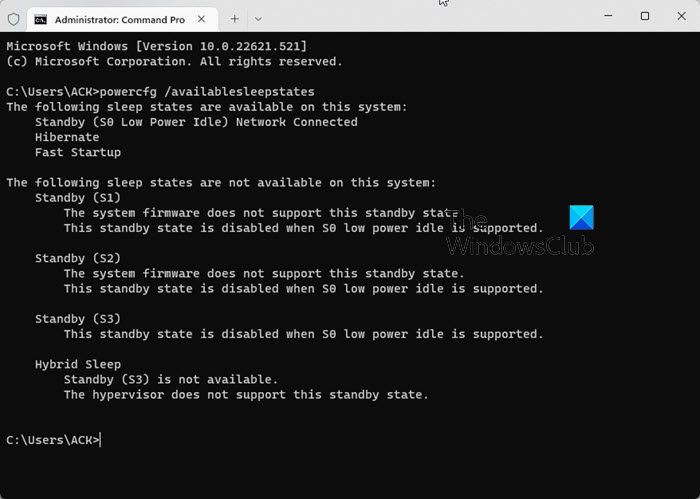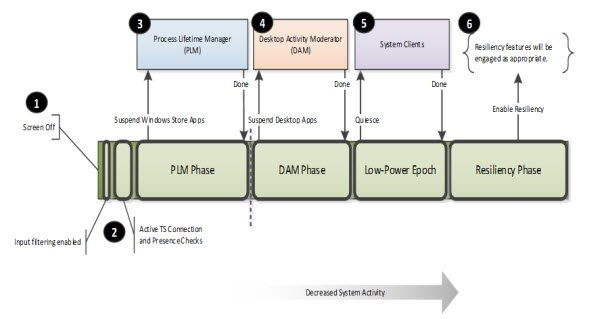When a computer is in a Sleep state, it is not performing any task and may appear to be off. But it is not shut down but retains the memory state. S0, S1, S2, S3, and S4 are the four power states, of which S1, S2, S3, and S4 are the three sleeping states. With each successive sleep state, from S1 to S4, more of the computer is shut down. S5 is the classic complete shutdown power state.

Power States in Windows 11/10
In this post, we will see the different System Sleep States in Windows:
- System Power State S0 – This is the Working State, where your Windows PC is awake. This is not a Sleep state.
- System Power State S1 – In this sleep state, the CPU is stopped and your computer is in standby mode. If the next S3 state is note supported, this S2 is the default state on most hardware. The Processor clock is off and bus clocks are stopped. In this state, the power consumption could be between 5 – 30 Watts.
- System Power State S2 – This state is similar to S1 except that the CPU context and contents of the system cache are lost because the processor loses power.
- System Power State S3 – In this state, data or context is saved to RAM and hard drives, fans, etc. are shut down. The power consumption is usually less than 5 Watts. Wake-On-LAN is supported from S3 (Sleep) or S4 (Hibernate) state in Windows 11/10/8.
- System Power State S4 – In this state, data or context is saved to Disk. It is also known as the Hibernate state and is useful for laptops. Your PC saves the contents of RAM to the hard disk. The hardware powers off all devices. The operating system context, however, is maintained in a hibernate file that the system writes to disk before entering the S4 state. Upon restart, the loader reads this file and jumps to the system’s previous, pre-hibernation location. Power consumption is again less than 5 Watts.
Microsoft explains this further quite well.
Read: Difference between Sleep, Hybrid Sleep & Hibernation.
How to check System Power States available on your Windows 11/10 PC?
To check if the power states supported, run the powercfg option from a command prompt. When you type the following command and press Enter, you’ll see the Standby (Connected) option only if you have InstantGo:
powercfg /availablesleepstates
OR
powercfg /a
Modern Standby State in Windows 11/10
In Windows 11/10, there is a new state called the Modern Standby State.
Connected Standby brings the smartphone power model to the PC. It provides an instant on, instant off user (InstantGo)experience that users have come to expect on their phone. And just like on the phone, it enables the system to stay fresh, up-to-date, and reachable whenever a suitable network is available.
You can read more about Modern Standby State here on microsoft.com.
The Slide To Shut Down feature in Windows 11/10/8.1 will work only if the hardware supports Connected Standby State.

How does Modern Standby differ from Sleep and Hibernate
Sleep and Hibernate are system-wide coordinated sleep states. When the operating system enters or exits one of these states, it must transition the system in a coordinated manner across applications, services, drivers, devices, and firmware. These transitions require coordination and processing across many layers in the system, many of which are provided by third parties. Therefore, these transitions can be relatively time-consuming and prevent transitions from being near-instant to the user.
Modern Standby is neither a sleep state nor a fully coordinated, system-wide power state transition. The system is still on but the display is powered off and the system is driven to be as idle as possible. The goal is to provide a seamless on/off experience and constant connectivity while delivering consistently long battery life. Systems that support it do not support Sleep (or ACPI S3) because Modern Standby effectively replaces the Sleep experience. Modernd Standby-capable systems running on x86 platforms do support Hibernate. Hibernate is not supported on ARM-based platforms.
Modern Standby is more inclusive than the Windows 8.1 Connected Standby power model. Modern Standby allows for market segments previously limited to the Traditional Sleep (S3) power model to take advantage of the low power idle model.
TIP: Find out if your Windows computer supports InstantGo Power State.
Thanks a lot !